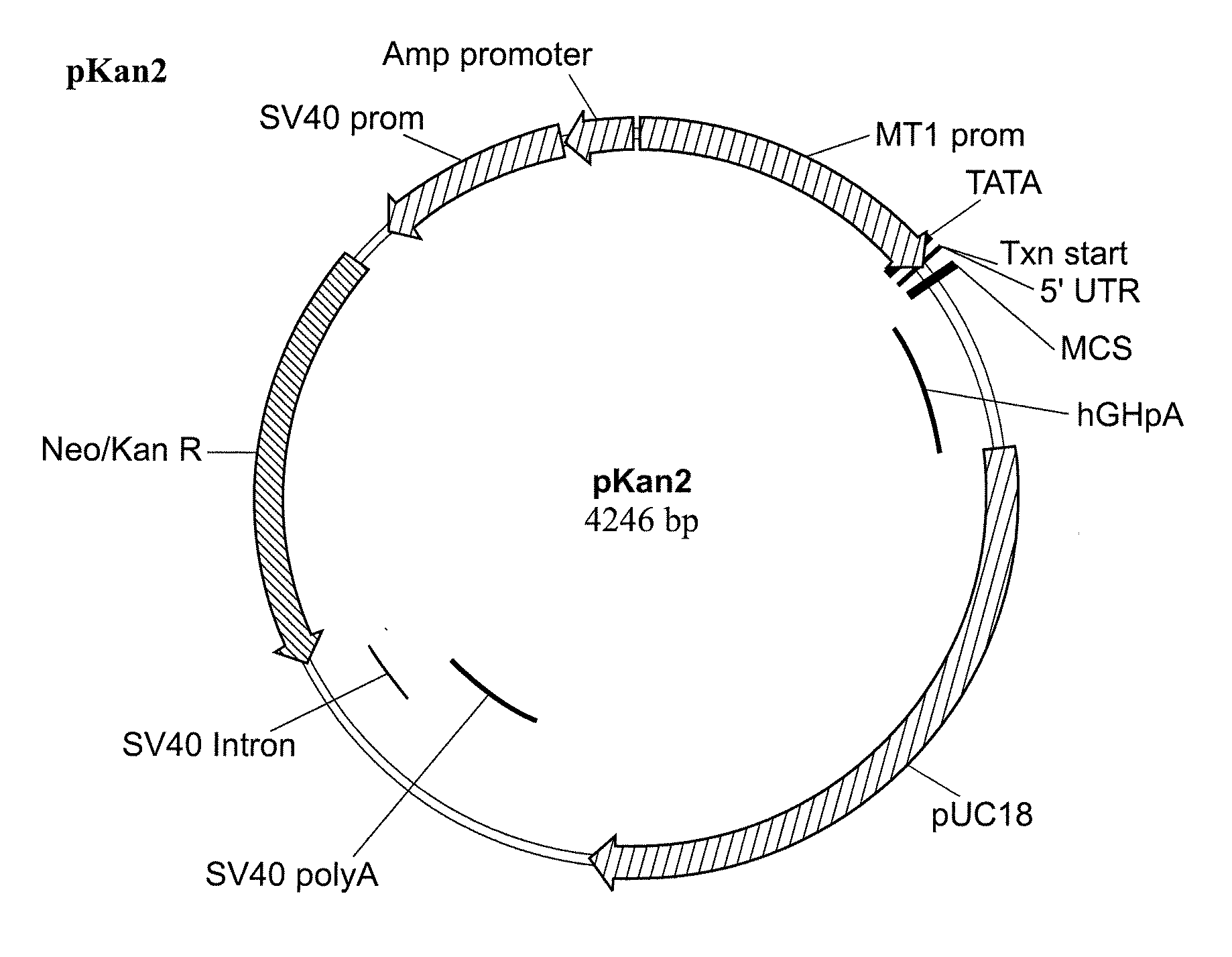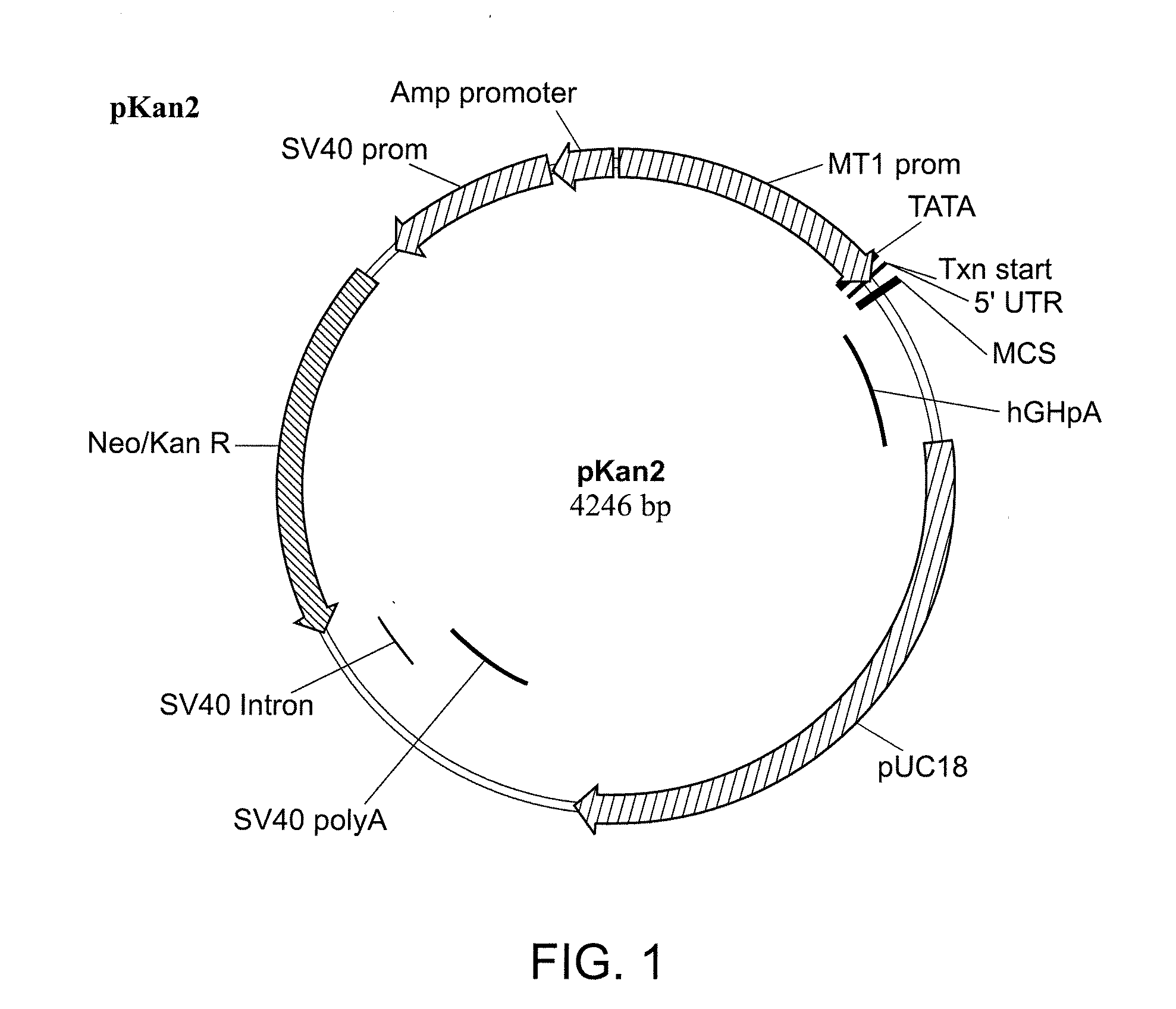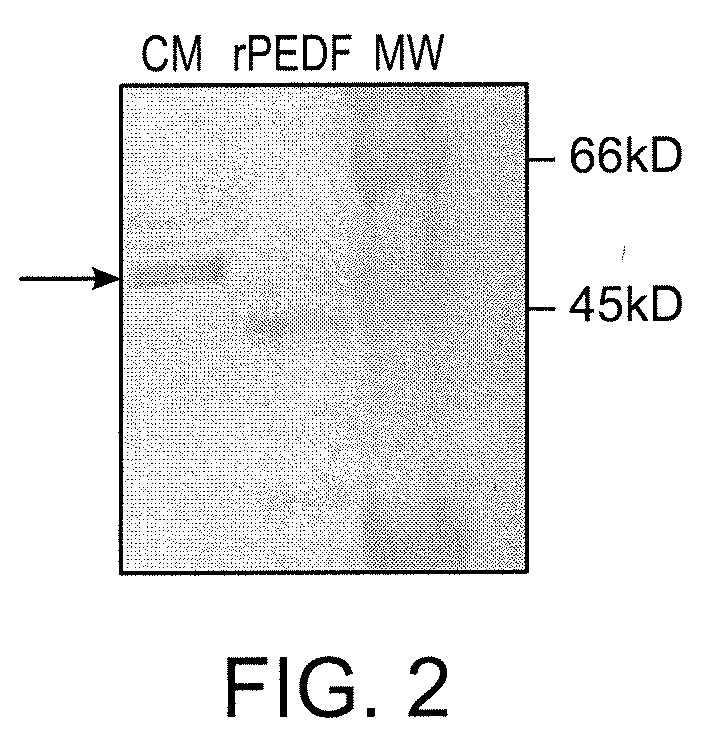Use of PEDF in an Encapsulated Cell-Based Delivery System
a cell-based delivery and encapsulation technology, applied in the direction of genetically modified cells, prosthesis, peptide/protein ingredients, etc., can solve the problems of ineffective protein or peptide-based therapeutics in particular, difficult to administer to the eye, and ineffective oral administration of protein or peptide-based therapeutics, etc., to achieve inhibition of neural or retinal degradation
- Summary
- Abstract
- Description
- Claims
- Application Information
AI Technical Summary
Benefits of technology
Problems solved by technology
Method used
Image
Examples
example 1
Sub-Cloning
[0209]cDNA encoding human PEDF (GenBank Accession No. NM—002615) was subcloned into Neurotech mammalian expression vector pKAN2, a schematic of which is shown in FIG. 1. The pKAN2 backbone is based on the pNUT-IgSP-hCNTF expression plasmid used to create the ARPE-19-hCNTF cell lines.
[0210]The nucleotide sequence of pKAN2 is shown below in SEQ ID NO: 3:
cttggtttttaaaaccagcctggagtagagcagatgggttaaggtgagtgacccctcagccctggacattcttagatgagccccctcaggagtagagaataatgttgagatgagttctgttggctaaaataatcaaggctagtctttataaaactgtctcctcttctcctagcttcgatccagagagagacctgggcggagctggtcgctgctcaggaactccaggaaaggagaagctgaggttaccacgctgcgaatgggtttacggagatagctggctttccggggtgagttctcgtaaactccagagcagcgataggccgtaatatcggggaaagcactatagggacatgatgttccacacgtcacatgggtcgtcctatccgagccagtcgtgccaaaggggcggtcccgctgtgcacactggcgctccagggagctctgcactccgcccgaaaagtgcgctcggctctgccaaggacgcggggcgcgtgactatgcgtgggctggagcaaccgcctgctgggtgcaaaccctttgcgcccggactcgtccaacgactataaagagggcaggctgtcctctaagcgtcacccctagagtcgagctgtgacggtccttacactcgagac...
example 2
Cell Line and Device Construction
[0212]Verified plasmid clones were used to transfect NTC-200 cells to obtain stable polyclonal cell lines. Briefly, 200-300K cells, plated 18 hours previously, were transfected with 3.0 ug of plasmid DNA using 6.0 ul of Fugene 6 transfection reagent (Roche Applied Science, Indianapolis Ind.) according to the manufacturer's recommendations. Transfections were performed in 3.0 ml of DMEM / F12 with 10% FBS, Endothelial SFM or Optimem media (Invitrogen Corp, Carlsbad, Calif.). Twenty four to 48 hours later cells were either fed with fresh media containing 1.0 ug / ul of G418 or passaged to a T-25 tissue culture flask containing G418. Cell lines were passaged under selection for 14-21 days until normal growth resumed, after which time drug was removed and cells were allowed to recover (˜1 week) prior to characterization.
[0213]Expression stability of the recombinant protein from these cell lines was measure over the course of several weeks using the Human PED...
example 3
Protein Characterization
[0217]Expression of PEDF from stably transfected cell lines was quantified by analyzing conditioned media from cell monolayers using a commercially available ELISA kit (BioProducts Maryland, Middletown, Md.). Conditioned media from stably transfected cells was analyzed by a colorimetric Western blot assay to determine protein integrity.
PUM
| Property | Measurement | Unit |
|---|---|---|
| Mass | aaaaa | aaaaa |
| Diameter | aaaaa | aaaaa |
| Diameter | aaaaa | aaaaa |
Abstract
Description
Claims
Application Information
 Login to View More
Login to View More - R&D
- Intellectual Property
- Life Sciences
- Materials
- Tech Scout
- Unparalleled Data Quality
- Higher Quality Content
- 60% Fewer Hallucinations
Browse by: Latest US Patents, China's latest patents, Technical Efficacy Thesaurus, Application Domain, Technology Topic, Popular Technical Reports.
© 2025 PatSnap. All rights reserved.Legal|Privacy policy|Modern Slavery Act Transparency Statement|Sitemap|About US| Contact US: help@patsnap.com



